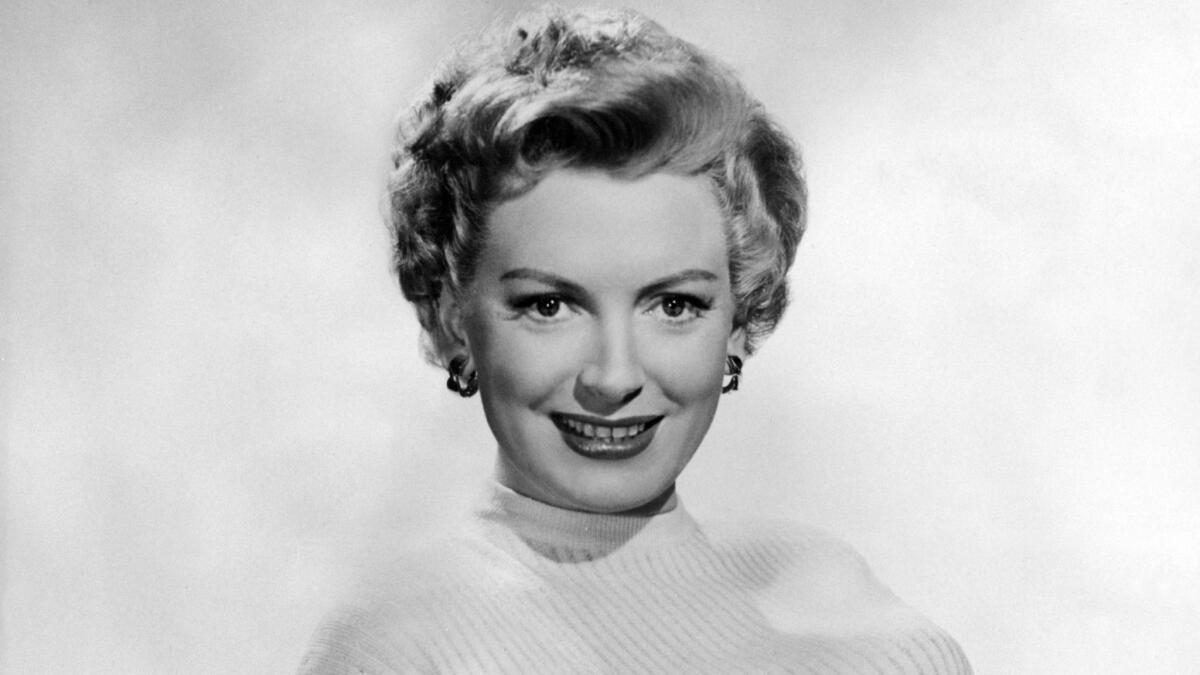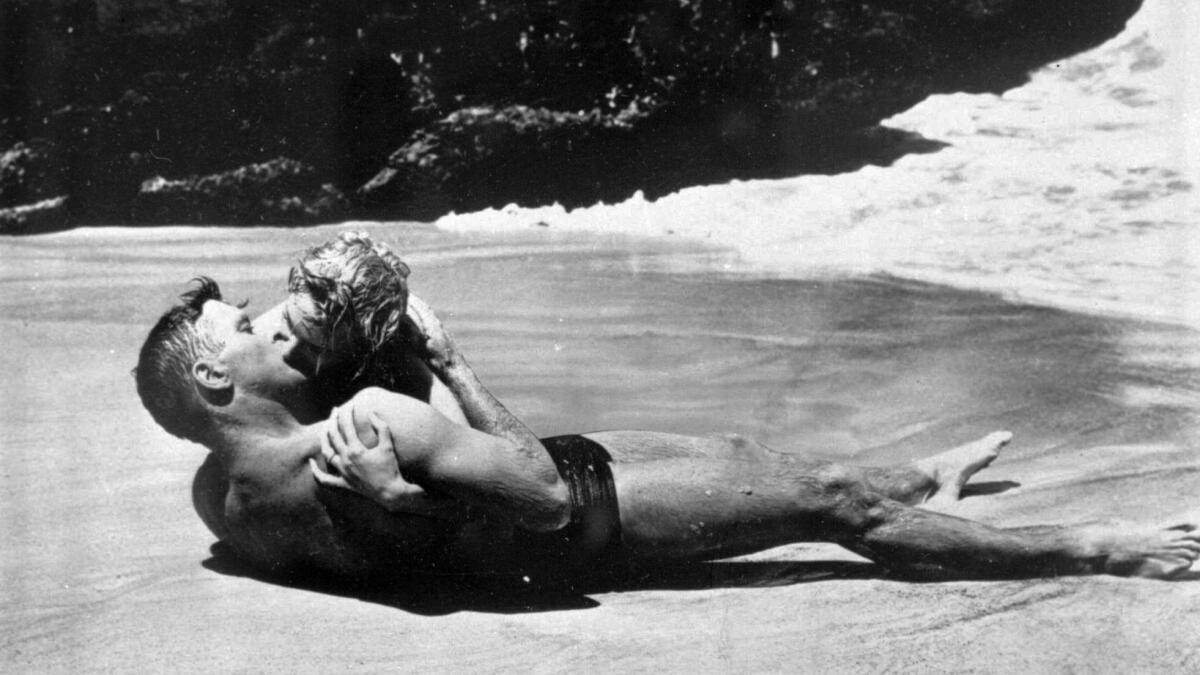From the Archives: Deborah Kerr, 86; ‘Eternity’ star

- Share via
Deborah Kerr, the acclaimed British actress whose versatile talent and refined screen persona made her one of Hollywood’s top leading ladies in the 1950s in films such as “From Here to Eternity,” “The King and I” and “An Affair to Remember,” has died. She was 86.
Kerr, who in recent years had Parkinson’s disease, died Tuesday in Suffolk, in eastern England, her agent, Anne Hutton, said Thursday in London.
In a screen career that was launched in the early 1940s, Kerr received six Academy Award nominations as best actress for her roles in “Edward, My Son” (1949), “From Here to Eternity” (1953), “The King and I” (1956), “Heaven Knows, Mr. Allison” (1957), “Separate Tables”(1958) and “The Sundowners” (1960).
Kerr received an honorary Oscar in 1994 for her body of work in films that also included “Tea and Sympathy,” “Beloved Infidel” and “The Night of the Iguana.” For many movie fans, particularly women, Kerr may be best remembered for what is considered one of the all-time great romantic tear-jerkers: “An Affair to Remember,” the 1957 film about a shipboard romance co-starring Cary Grant.
The postwar personification of the British gentlewoman, Kerr was born in Scotland and began her film career in England in 1940. She had been in 10 films before coming to Hollywood to co-star with Clark Gable in the 1947 MGM film “The Hucksters.”
When she arrived after playing a nun in the British film “Black Narcissus,” she not only was preceded by her reputation as a lady but for being, in the words of Laurence Olivier, “unreasonably chaste.”
But Kerr memorably shattered that image in 1953 with “From Here to Eternity,” in which she played an American Army officer’s adulterous wife who has an affair with a sergeant played by Burt Lancaster.
Her performance as the disillusioned Karen Holmes not only showed audiences a different side of Kerr, but the film boasts one of the most memorable scenes in screen history: Kerr and Lancaster locked in a passionate embrace on a deserted Hawaiian beach as a wave washes over them.
“That certainly shook a few people up,” Kerr said of her image-breaking role in a 1986 interview with the Chicago Tribune.

“Yes, people always think I’m the epitome of the English gentlewoman,” she added with a laugh, “which just goes to show that things are never quite what they seem.”
Kerr’s versatility as an actress made her unique among Hollywood leading ladies of the 1950s, said Jeanine Basinger, head of the film studies program at Wesleyan University and the author of “A Woman’s View: How Hollywood Spoke to Women.”
“Generally, you had sort of archetypes: female stars that were sex symbols like Marilyn Monroe and female stars that were ladylike like Audrey Hepburn. Deborah Kerr could do both,” Basinger told The Times.
But even while playing an unfaithful wife in from “From Here to Eternity,” Kerr is dignified, Basinger said. “She could give you the whole range in one performance, and that made her unique.”
She was born Deborah Jane Kerr-Trimmer in Helensburgh, Scotland, on Sept. 30, 1921, and was a young child when her family moved to Alford, England.
Kerr, who loved to sing and dance as a child, won a scholarship to the Sadler’s Wells ballet school in London and made her professional stage debut in 1938 as a member of the corps de ballet in “Prometheus.”
“I was mad about ballet, but I grew too tall, and when I eventually realized I’d never become the second Margot Fonteyn, I auditioned for a play instead and got the part,” she told the Chicago Tribune in 1986.
Kerr was playing walk-on parts with the Open Air Theatre in Regent’s Park in 1939 when London film agent John Gliddon saw the company’s production of “Pericles,” in which Kerr had a tiny role.
Kerr had no lines, but Gliddon later said he was so taken with the expressiveness of her eyes and her graceful movements that he sought her out and offered to put the 17-year-old under contract.
Her film debut came in 1941, in a screen adaptation of the George Bernard Shaw comedy “Major Barbara,” starring Wendy Hiller and Rex Harrison.
Kerr’s small but key role as Salvation Army worker Jenny Hill was, according to Eric Braun in his 1977 biography “Deborah Kerr,” “a signpost to the kind of part in which she would excel — moral fortitude concealed by a frail appearance.”
In 1945, while in a touring company that performed “Gaslight” for British troops, she met Royal Air Force squadron leader Anthony Bartley. They were married later that year and had two daughters, Melanie and Francesca.
The marriage ended in divorce in 1959; a year later Kerr married screenwriter and novelist Peter Viertel, who survives her, as do her daughters and three grandchildren.
“Black Narcissus,” a 1947 drama about nuns trying to establish a religious community in a Himalayan outpost, earned Kerr a New York Film Critics Circle Award as best actress. The film was shot just before Kerr arrived in Hollywood.
Signed to a seven-year contract with MGM, Kerr received her first best actress Oscar nomination playing Spencer Tracy’s wife in director George Cukor’s 1949 drama “Edward, My Son.”
Over the next four years, she appeared in films such as “Quo Vadis,” “Julius Caesar,” “King Solomon’s Mines,” “The Prisoner of Zenda” and “Young Bess.”
Then came “From Here to Eternity.”
Joan Crawford was originally scheduled to play the part of Karen Holmes in the screen version of James Jones’ bestseller, which was set in Hawaii in the days leading up to Japan’s attack on Pearl Harbor. But Crawford had angered Columbia studio head Harry Cohn by insisting on using her own cameraman to shoot the picture.
When Kerr’s agent asked her if she’d be interested in playing the part, she reportedly told him, “They’d never consider me. You must be crazy! Harry Cohn will kick you out of the office.”
The next day, her agent called her and said, “You were right; he kicked me out of the office.”
But that wasn’t the end of the matter. According to Braun’s biography, when Cohn told producer Buddy Adler and director Fred Zinnemann that Kerr’s agent had “suggested that English virgin from Metro” play Karen Holmes, Adler and Zinnemann, Braun wrote, “looked at each other in frank astonishment and echoed: ‘What a fantastic idea!’ ”
For the role, Kerr took voice training to sound American. She also dyed her hair blond. “I knew I could be sexy if I had to,” she later said.
Zinnemann once said he thought that by casting Kerr against her screen image, it would be hard for audiences to believe she was an unfaithful wife and that would make them curious to see what happened.
Kerr told Braun that Zinnemann’s encouragement “in playing against typecasting was a deciding factor in lifting me out of the rut of ladylike roles from which I’d begun to feel there was no exit.”
Kerr later recalled that Zinnemann took a long time searching for the right beach to film her famous love scene with Lancaster.
“It had to have rocks in the distance, so the water could strike the boulders and shoot upward — all very symbolic,” she told The Times in 1982. “The scene turned out to be deeply affecting on film, but, God, it was no fun to shoot.
“We had to time it for the waves, so that at just the right moment a big one would come up and wash over us. Most of the waves came up only to our feet, but we needed one that would come up all the way. We were like surfers, waiting for the perfect wave. Between each take, we had to do a total cleanup. When it was all over, we had four tons of grit in our mouths -- and other places.”
In 1953, Kerr made her Broadway debut in Robert Anderson’s critically acclaimed play “Tea and Sympathy,” in which she played the compassionate wife of a housemaster at a New England boys’ school who befriends a sensitive 17-year-old student falsely accused by his classmates of being homosexual.
In the play’s famous climactic scene, Kerr’s character enters the room of the boy, whose emotional suffering has increased after a failed sexual encounter with the town tart. Unbuttoning the top button of her blouse, she reaches out for the boy’s hand and sits down on his bed.
“Years from now, when you talk about this — and you will — be kind,” she said as the stage lights dimmed.
The director, Elia Kazan, wrote in his 1988 autobiography, “Elia Kazan: A Life,” that the play’s ending produced the “awed silence that comes when the audience is deeply moved. There is nothing so eloquent and so heartening. When we had that, I knew we were going to run a long time.”
Kerr reprised her role in the reworked and much-censored 1956 MGM film version of the play.
On screen the same year, she played another of her memorable roles, Anna, the governess in “The King and I,” opposite Yul Brynner. In the film, according to Braun’s biography, Kerr sang all of “I Whistle a Happy Tune” and sang well enough to do the lead-ins to most of the Rodgers and Hammerstein songs, but singer Marni Nixon sang “the high notes and those which needed sustaining.”
After co-starring in Kazan’s 1969 film “The Arrangement,” Kerr made only one other theatrical feature film, “The Assam Garden” (1985). She didn’t plan to retreat from the big screen in 1969 but was, she said, merely waiting for the next good part.
She found, however, that she was “either too young or too old” for the film roles that were offered to her, and she didn’t want to do the kinds of movies that Hollywood had started making that featured explicit sex and violence.
Kerr continued acting on stage over the years, appearing in, among other productions, Frank Harvey’s “The Day After the Fair” in London and on tour in the U.S., Emlyn Williams’ “The Corn is Green” in London, Edward Albee’s “Seascape” on Broadway and Eugene O’Neill’s “Long Day’s Journey Into Night” in Los Angeles. She also appeared in TV and cable productions in the 1980s, including “Witness for the Prosecution,” “A Woman of Substance,” “Reunion at Fairborough” and “Hold the Dream.”
In 1993, “Sleepless in Seattle” gave an unexpected boost to one of Kerr’s most beloved movies. In one scene, Meg Ryan watches a video of “An Affair to Remember” and sobs, “Those were the days when people knew how to be in love.”
Kerr said at the time: “I’m almost hysterical at the thought of making people cry with joy 30-odd years after Cary and I did our stuff. I’ve certainly shed tears at ‘An Affair to Remember,’ even though I know all the tricks of movie magic that went into it.”
She added, “Believe me, Cary and I knew how to kiss. When we did a love scene, we may not have been trying to swallow each other but, for those brief moments, we just loved each other.
“I think I understand what women see in the movie. There is a sweetness that is appealing and far removed from today’s crudities. It makes them realize that the world has lost something delightful.”
From the Archives: Passionate Star Anthony Quinn Dies
From the Archives: Mel Ferrer, versatile actor, dies at 90
From the Archives: Laurence Olivier, Called Greatest Actor of His Time, Dies
From the Archives: Jane Greer; Star of Film Noir ‘Out of the Past’
From the Archives: Ella Fitzgerald, Jazz’s First Lady of Song, Dies
More to Read
Start your day right
Sign up for Essential California for the L.A. Times biggest news, features and recommendations in your inbox six days a week.
You may occasionally receive promotional content from the Los Angeles Times.






